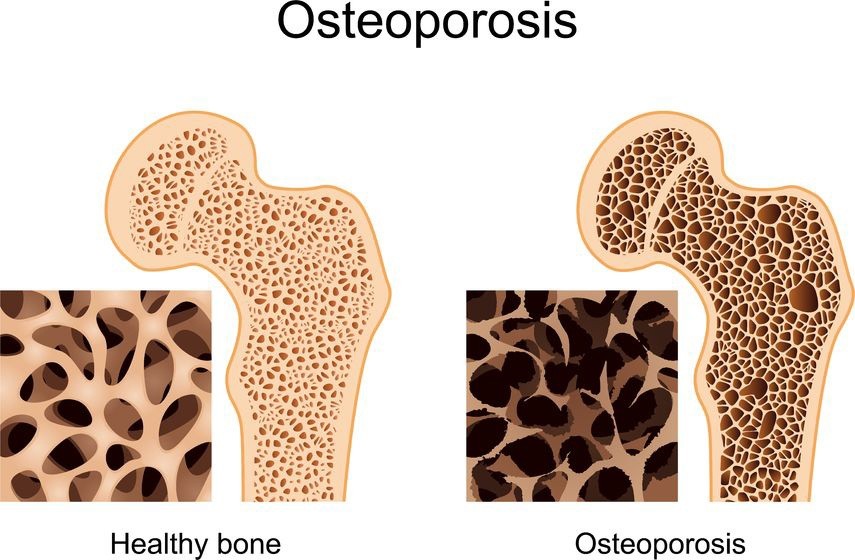Osteoporosis - Symptoms and Treatments

What Is Osteoporosis?
Osteoporosis, also known as "brittle bone
disease", is an umbrella term for a set of metabolic diseases
characterized by low bone mineral density (BMD).
These diseases are caused by the thinning and
deterioration of the bones. As they progressively weaken, their ability to
support body weight is reduced, placing an increased load on other parts of the
body—such as muscle and joint tissue.
It is estimated that more than 49 million
Americans—about 10% of all adults aged 50 years or older—have osteoporosis for
this reason. It occurs most commonly at the hip, wrist, and spine.
A little more than 1% of all women above age 50 will
suffer from osteoporosis, while between 1-3% of men in the same age group are
at risk. Over time, bone deterioration gradually leads to bone fractures.
How Does Osteoporosis Occur?
Osteoporosis can occur if there is a deficiency or
disturbance in the body's ability to produce new bone tissue even though there
is no loss of old bone.
A "normal" level (< 2 mg/cm³) of
calcification in young adulthood cannot be sustained indefinitely because
calcification is a dynamic process that needs to progress continuously with
age.
Cessation of bone growth and the process of
ossification begins in humans after the age of 25. As a result, older people
have a greater risk of developing osteoporosis.
After the age of 25, bone mass is slowly lost because
human bodies are no longer growing in height and bone tissue.
In addition to this, there is a gradual decline in the
ability of bones to repair minor damage caused by everyday activities that
usually generate micro-fractures when people are young. This gradual decline in
tissue strength is due to a decrease in levels of minerals such as calcium and
magnesium in bones.
The normal body processes involved in the daily use and
maintenance of bones gradually remove minerals from these tissues.
In addition to lack of hormone production, other
contributing factors that may cause osteoporosis in adults to include:
·
Sedentary lifestyles. Inactivity causes bones to
break down faster than they can rebuild. Any exercise, even light activity such
as walking or gardening, can benefit bone strength and offset this effect.
· Smoking and drinking alcohol. These habits cause the body to leach calcium from bones and deposit toxic agents in bone tissue, eventually leading to increased vulnerability for fractures due to weakened bones.
What Are Risk The Factors
Older age; family history; sex;
race/ethnicity—especially Asian American, Hispanic, or Caucasian; low body
weight; low calcium intake; low physical activity level; smoking and alcohol
use.
Is Diabetes A Risk Factor For Osteoporosis?
Although diabetes is not a cause of osteoporosis in
itself, it can increase the risk. Diabetics are more likely to have low BMD
levels due to their glucose control, which may lead to diabetes complications.
Is Diet A Risk Factor For Osteoporosis?
Yes, an unhealthy diet can affect bone health. Studies
have shown that people with osteoporosis are more likely to have a high intake
of saturated fats and trans fats, which are found in certain foods such as red
meats, high-fat dairy products, packaged snack foods, pastries, fried foods,
and desserts.
Frequently Asked Questions
What Are The Symptoms Of Osteoporosis?
A normal adult should know if he or she has
osteoporosis or not. People with osteoporosis should be aware that daily
activities may become more difficult as the disease progresses.
Osteoporosis is a progressive bone disease
characterized by low density and low bone volume. In women, osteoporosis can
occur at any age, but it is most common between the ages of 50-70.
In men, osteoporosis usually occurs after age 50.
Symptoms of osteoporosis usually do not appear until after a person has been
diagnosed with the disease.
What Are Some Preventive Measures?
Scientific studies and clinical studies demonstrate
that the most effective way to prevent osteoporosis is to maintain a normal BMI
and avoid overweight or obesity.
Unfortunately, our current knowledge of preventing
osteoporosis has been limited by many factors, such as the lack of
standardization of diet and exercise regimens used in randomized clinical
trials.
Because such studies can be recruiting only people with
no obvious risk factors for osteoporosis, their findings may not apply to
individuals with other risk factors or at high risk for developing
osteoporosis.
